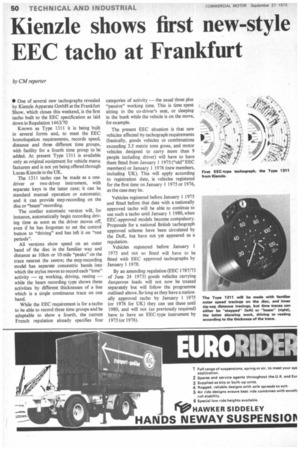Kienzle shows first new-style EEC tacho at Frankfurt
Page 52

If you've noticed an error in this article please click here to report it so we can fix it.
by CM reporter • One of several new tachographs revealed by Kienzle Apparate GmbH at the Frankfurt Show, which closes this weekend, is the first tacho built to the EEC specification as laid down in Regulation 1463/70 Known as Type 1311 it is being built in several forms and, to meet the EEC homologation requirements, records speed, distance and three different time groups, with facility for a fourth time group to be added. At present Type 1311 is available only as original eauipment for vehicle manufacturers and is not yet being offered through Lucas-Kienzle in the UK.
The 1311 tacho can be made as a onedriver or two-driver instrument, with separate keys in the latter case; it can be standard manual operation or automatic; and it can provide step-recording on the disc or "beam" recording.
The costlier automatic version will, for instance, automatically begin recording driving time as soon as the driver moves off, even if he has forgotten to set the control button to "driving" and has left it on "rest periods".
All versions show speed on an outer band of the disc in the familiar way and distance as 10km or 10-mile "peaks" on the trace nearest the centre; the step-recording model has separate concentric bands into which the stylus moves to record each "time" activity — eg working, driving, resting — while the beam recording type shows these activities by different thicknesses of a line which is a single continuous trace on one band.
While the EEC requirement is for a tacho to be able to record three time groups and be adaptable to show a fourth, the current French regulation already specifies four categories of activity — the usual three plus "passive" working time. This is time spent sitting in the co-driver's seat, or sleeping in the bunk while the vehicle is on the move, for example.
The present EEC situation is that new vehicles affected by tachograph requirements (basically, goods vehicles or combinations exceeding 3.5 metric tons gross, and motor vehicles designed to carry more than 9 people including driver) will have to have them fitted from January 1 1975 ("old" EEC members) or January 1 1976 (new members, including UK). This will apply according to registration date, ie vehicles registered for the first time on January 1 1975 or 1976, as the case may be.
Vehicles registered before January 1 1975 and fitted before that date with a nationally approved tacho will be able to continue to use such a tacho until January 1 1980, when EEC-approved models become compulsory. Proposals for a national British tachograph approved scheme have been circulated by the DoE, but have not yet appeared as a regulation.
Vehicles registered before January 1 1975 and not so fitted will have to be fitted with EEC approved tachographs by January 11978.
By an amending regulation (EEC 1787/73 of June 24 1973) goods vehicles carrying dangerous loads will not now be treated separately but will follow the programme outlined above. So long as they have a nationally approved tacho by January 1 1975 (or 1976 for UK) they can use these until 1980. and will not (as previously required) have to have an EEC-type instrument by 1975 (or 1976).
















































































































































































